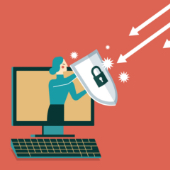 The coronavirus outbreak has necessitated people to work away from each other, so employees are now setting up offices at home. If you’re a remote worker, or if your business is planning to move to a work from home setup soon, make sure that your employees’ internet bandwidth can handle work-related processes. This way, your transition goes as smoothly as possible.
The coronavirus outbreak has necessitated people to work away from each other, so employees are now setting up offices at home. If you’re a remote worker, or if your business is planning to move to a work from home setup soon, make sure that your employees’ internet bandwidth can handle work-related processes. This way, your transition goes as smoothly as possible.
What is bandwidth?
Bandwidth refers to the maximum data transfer rate possible in a network or internet connection. It indicates the amount of data that can be sent over a connection in a given amount of time, and is usually expressed in bits per second (bps) or bytes per second (Bps).
Imagine two computers with the same internet speed at 100 megabit per second (Mbps): the first computer only has a 50 Mbps bandwidth, while the second one has 100 Mbps. If they were to download the same 500 Megabit (Mb) file, the first computer would be able to do it in 10 seconds, while the second one could do it in just five.
This is because the first computer’s bandwidth is capped at 50 Mbps — even if the internet was fast, the limit of transfer would still be low. Therefore, the higher the bandwidth, the more data can be sent over a connection, contributing to faster uploads and downloads, and overall better internet experience.
How much bandwidth do you need for remote working?
The answer to this question isn’t clear cut. The biggest considerations are the type of work that you do and the apps that you use. If your job mostly consists of sending emails, editing and writing on Google Docs, and communicating on Slack, then you can do your job with ease even with a low bandwidth. On the other hand, if you frequently attend meetings through video calls, then you’d definitely need a plan with higher bandwidth.
Once you have a clear picture of how much data you send and receive on an average work day, you can start looking for plans that can support your needs. And while you definitely don’t need to conduct virtual meetings in 4K quality, you also won’t want your clients and colleagues to appear pixelated during a meeting. Neither would you want a session that gets choppy or cut off mid-conversation.
Here are the minimum requirements for the most common video chat apps used by remote workers today:
For 1:1 video calling:
-
- 600 Kbps (up/down) for high-quality video
- 1.2 Mbps (up/down) for 720p HD video
- Receiving 1080p HD video requires 1.8 Mbps (up/down)
- Sending 1080p HD video requires 1.8 Mbps (up/down)
For group video calling:
-
- 800 Kbps/1.0 Mbps (up/down) for high-quality video
- For 720p HD video: 1.5 Mbps (up/down)
- Receiving 1080p HD video requires 2.5 Mbps (up/down)
- Sending 1080p HD video requires 3.0 Mbps (up/down)
HD video quality
-
- Outbound signals must always meet a 3.2 Mbps bandwidth requirement.
- Inbound signals: 2.6 Mbps with two participants; 3.2 Mbps with five participants; and 4.0 Mbps with 10 participants
Standard definition (SD) video quality
-
- Outbound signals must always meet a 1 Mbps bandwidth requirement.
- Inbound signals: 1 Mbps with two participants; 1.5 Mbps with five participants; and 2 Mbps with 10 participants
Video calling
-
- HD: 1.2 Mbps (up/down)
- SD: 400 Kbps (up/down)
- The more participants, the higher the bandwidth requirement for downloads: 512 Kbps for three participants; 2 Mbps for five participants; and 4 Mbps for seven people. Upload requirements remain constant at 128 Kbps.
Teams requires the same upload and download internet bandwidth for the following scenarios:
-
- 30 Kbps for peer-to-peer audio calling
- 1.2 Mbps for peer-to-peer HD-quality video calling at 720p
- 1.5 Mbps for peer-to-peer HD-quality video calling at 1080p
- 500 Kbps/1 Mbps for group video calling
If you’re worried about your internet bandwidth, you can opt for audio calls instead of video calls. This considerably helps lower the information you need to upload and download. For more tips and solutions on how you can work from home without a hitch, call us. We’d be happy to help.

 For many businesses, remote working seemed impossible for a multitude of operational and financial reasons. But with the COVID-19 pandemic relentlessly plaguing the world, working from home has become the new standard. How will this change the corporate setup?
For many businesses, remote working seemed impossible for a multitude of operational and financial reasons. But with the COVID-19 pandemic relentlessly plaguing the world, working from home has become the new standard. How will this change the corporate setup? Remote work policies have become a necessity not just because of the current coronavirus crisis, but also for the ways they improve a company’s bottom line and efficiency. Yet despite remote work’s benefits, it leaves you and your company exposed to online scams and other cybersecurity threats. To defend your company and your remote workers, make sure to heed the following tips.
Remote work policies have become a necessity not just because of the current coronavirus crisis, but also for the ways they improve a company’s bottom line and efficiency. Yet despite remote work’s benefits, it leaves you and your company exposed to online scams and other cybersecurity threats. To defend your company and your remote workers, make sure to heed the following tips.